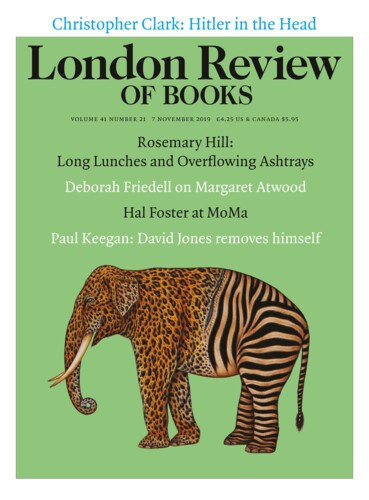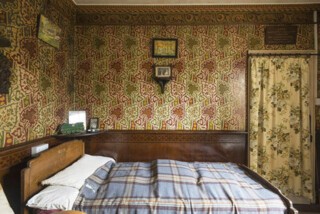Gwydir Street in Cambridge, just off the appealingly scruffy Mill Road, is a narrow street of Victorian terraced houses. In the 1980s my secondary school English teacher lived there: he would drive his Morris Minor out to our village to tell us about books and music and more books. In my mind, Gwydir Street was the sophisticated centre of the urban world. Walk down it now, past the old Dewdrop Inn (a Victorian joke: ‘do drop in’) and you barely notice Number 186. A two-storey artisan’s cottage, just as ordinary from the outside as the rest, it is open – two days a week at least – as the David Parr House, after its one-time owner.
The narrow hallway is dark; your eyes have to adjust to the dimness. A half-circle of stained glass above the front door lets in some light, but it’s quickly absorbed by the brown-painted wood on the walls. Step into the drawing room, however, and you’re suddenly, implausibly surrounded by decoration and colour. Pale green stalks, leaves, tulip buds and flowers are intertwined on the walls and there’s a narrow frieze just below the ceiling. The pattern seems to have been inspired by a William Morris design for Swan House in Chelsea. Parr, an artisan decorator for the Cambridge firm F.R. Leach, was among the people who implemented Morris’s designs at Swan House and elsewhere. He also brought them home.
F.R. Leach specialised in a process called ‘pouncing’, which involved covering the walls with lining paper and using semi-transparent paper pierced with holes to transfer the designs (you dabbed the paper with powder); this was followed by freehand painting in oils – difficult to work with and slow to dry. The freehand technique allowed for playful variations: in Gwydir Street, one of the tulip buds is tightly closed; another, further along, is wide open. And then there’s the splendour of the fireplace surround, which incorporates Abyssinian gold leaf. The ceiling, with its intricate foliate design, is probably inspired by Morris’s design for the ceiling of the Ambassador’s Room at St James’s Palace. It was time-consuming work. Parr recorded in his notebook that it took him 75 hours to paint the frieze that runs round the walls of the dining room.
Parr was born in 1854 in Chesterton, which is now a Cambridge suburb but was then a working-class satellite village. He was largely raised by his uncle, a cask-maker, after his mother died of tuberculosis and his father was jailed for stealing a pig. As a teenager he was apprenticed to F.R. Leach, where he worked with the celebrated stained-glass artist Charles Eamer Kempe and the church architect George Frederick Bodley as well as with Morris. Among other projects, he worked in Cambridge on the Gothic interior of All Saints Church and Queen’s Old Hall; in London, he worked on the mansions of the Gilbert Scott, Flower and Howard families. He bought 186 Gwydir Street in 1886 with money he’d saved in his post office account and, with his wife, Mary Jane, and their three children, lived there until he died, in 1927. Transforming the interior of his own house was a lifelong project; he often stayed up after a full day’s work to carry on by candlelight.
The opulence of Parr’s decoration stands in contrast to the 1940s and 1950s furniture and kitsch knick-knacks that fill the rooms. The squashy armchair, the Union Jack-covered mementos, the fancy teapot that resembles a country cottage (mounted on a wooden shelf nailed into the parlour wall): all these belonged to Parr’s granddaughter Elsie, who moved into the house after his death and stayed there until she died in 2013 at the age of 98. The domestic clutter tells a story that is just as interesting as the one displayed on the walls. There are two histories here: one from the forty-year period when Parr was painstakingly decorating the house; another from the 1950s and 1960s, when Elsie made it entirely her home. Her pottery, embroidered samplers, jam jar filled with old hot-water bottle stoppers and postcards from seaside resorts bang up against – but don’t diminish – the Arts and Crafts interior.
When I walked into Elsie’s tiny kitchen, I was transported back to my godmother’s kitchen thirty years ago. Like Elsie, she was a self-sufficient woman who lived alone in a small terraced house in Cambridge. The David Parr House is full of familiar signs of quiet industriousness. Elsie’s yellow floral housecoat hangs on the kitchen wall next to her string shopping bag and a large scrubbing brush. My godmother wore a similar housecoat to do her ‘jobs’, as she called them, which included sweeping out the grate of her coal fire. Elsie’s small kitchen table, pushed up against a window, reminded me of my godmother’s table, where we used to eat stew out of blue enamel bowls. One difference: my godmother had a fridge, from which she would extract sugar-covered grapes for us as a treat. Elsie had to make do with a bucket for a cool box.
In some rooms the curators have reinstalled Bakelite switches for an authentic early-century look – but elsewhere the later white plastic remains. Upstairs there is more brown paint on the woodwork. In the small back bedroom hang sheets of canvas that Parr never got round to painting on. Further along the corridor, the walls of the main bedroom are an Arts and Crafts marvel with a pattern of red and green-edged leaves on red and green stalks and an ornate painted wooden ceiling. Elsie’s floral dresses hang neatly in the fitted wardrobe. A nice 1970s light pull hangs over the middle of the bed.
The house could have been forgotten – or snapped up, replastered, rewired, repainted, sold off. But ten years ago Tamsin Wimhurst, a social historian, started interviewing local people about the street and its history, and came across Number 186. She and her husband bought it in 2013. It was in a bad state: the roof was leaking and it was full of damp. They made the building watertight and, thanks to a sizeable Lottery grant, the process of restoring the interior began. It has now been turned back into a house full of secrets and treasures, where the everyday and the extraordinary sit side by side. Recently, Wimhurst and her husband bought the house next door, and turned it into a visitor centre, with a rental flat above to help generate income for the museum. After I walked in, it took a few minutes before I realised I’d been there before. A while ago, 184 Gwydir Street had been available to let as an ordinary family house and for a moment – whether out of nostalgia or desire for a change – I’d considered renting it. The green-painted kitchen I saw then has been ripped out; the back room is now decked out with samples of paint, fabrics and patterns to teach visitors about Parr and Morris and Co. I thought I remembered the ornate fireplace in the front room from my earlier visit, but it turns out it was salvaged from the F.R. Leach workshops in 2014 and installed during the recent building works. Memory is a tricky thing.
Send Letters To:
The Editor
London Review of Books,
28 Little Russell Street
London, WC1A 2HN
letters@lrb.co.uk
Please include name, address, and a telephone number.


